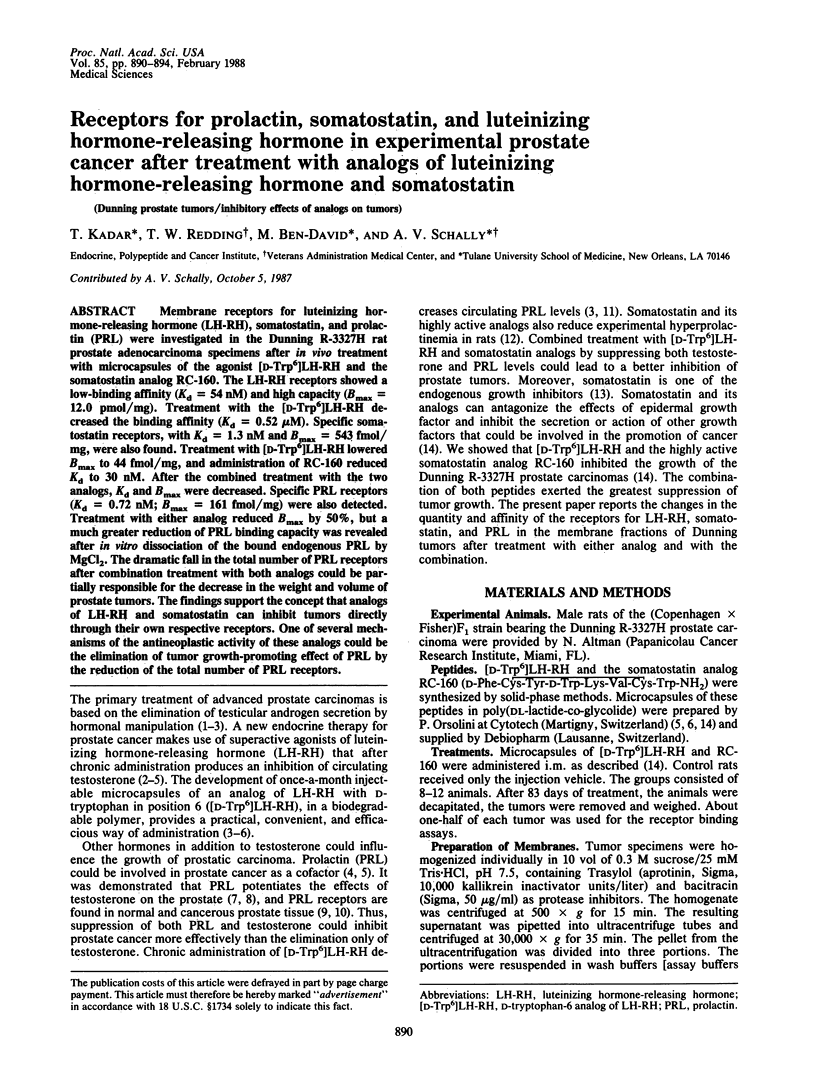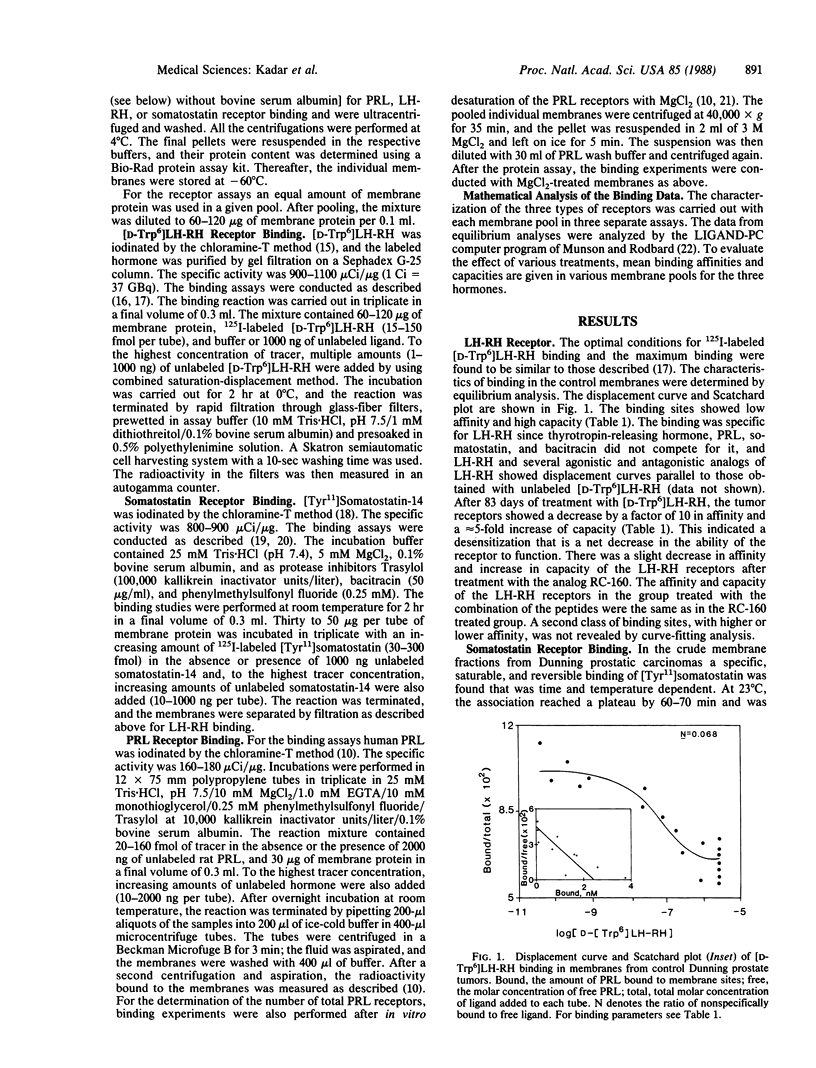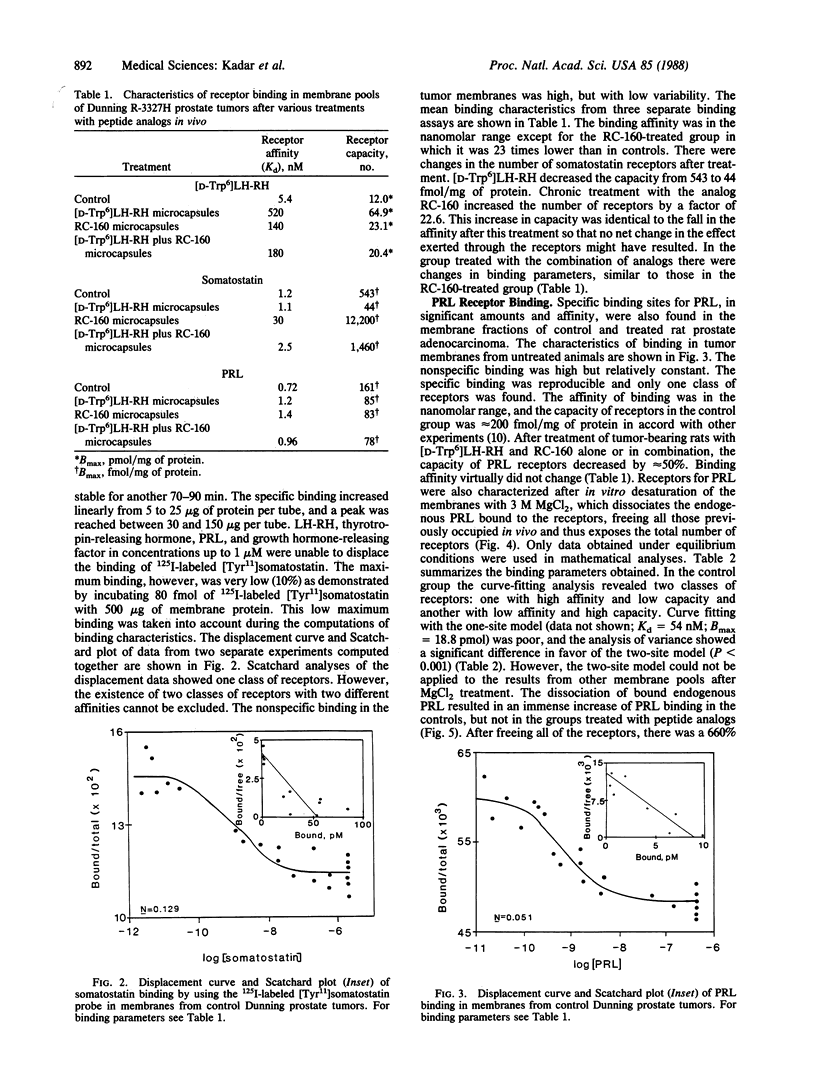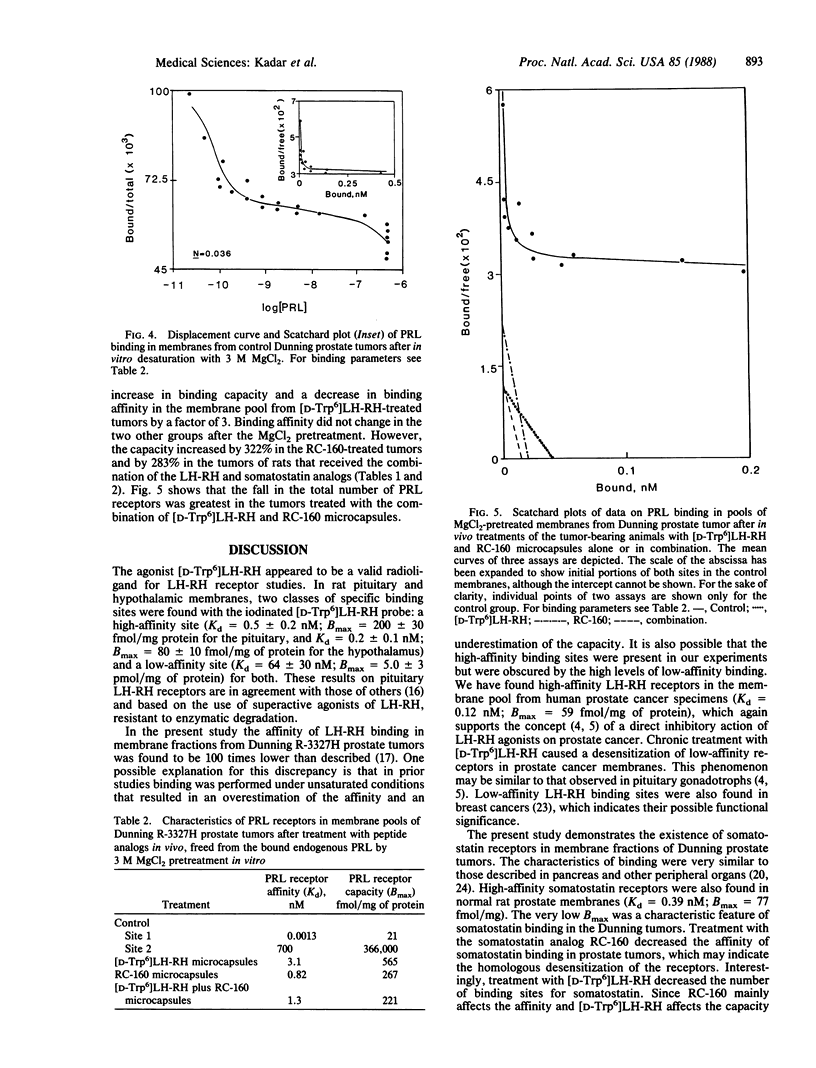Abstract
Membrane receptors for luteinizing hormone-releasing hormone (LH-RH), somatostatin, and prolactin (PRL) were investigated in the Dunning R-3327H rat prostate adenocarcinoma specimens after in vivo treatment with microcapsules of the agonist [D-Trp6]LH-RH and the somatostatin analog RC-160. The LH-RH receptors showed a low-binding affinity (Kd = 54 nM) and high capacity (Bmax = 12.0 pmol/mg). Treatment with the [D-Trp6]LH-RH decreased the binding affinity (Kd = 0.52 microM). Specific somatostatin receptors, with Kd = 1.3 nM and Bmax = 543 fmol/mg, were also found. Treatment with [D-Trp6]LH-RH lowered Bmax to 44 fmol/mg, and administration of RC-160 reduced Kd to 30 nM. After the combined treatment with the two analogs, Kd and Bmax were decreased. Specific PRL receptors (Kd = 0.72 nM; Bmax = 161 fmol/mg) were also detected. Treatment with either analog reduced Bmax by 50%, but a much greater reduction of PRL binding capacity was revealed after in vitro dissociation of the bound endogenous PRL by MgCl2. The dramatic fall in the total number of PRL receptors after combination treatment with both analogs could be partially responsible for the decrease in the weight and volume of prostate tumors. The findings support the concept that analogs of LH-RH and somatostatin can inhibit tumors directly through their own respective receptors. One of several mechanisms of the antineoplastic activity of these analogs could be the elimination of tumor growth-promoting effect of PRL by the reduction of the total number of PRL receptors.
Full text
PDF




Selected References
These references are in PubMed. This may not be the complete list of references from this article.
- Assimos D., Smith C., Lee C., Grayhack J. T. Action of prolactin in regressing prostate: independent of action mediated by androgen receptors. Prostate. 1984;5(6):589–595. doi: 10.1002/pros.2990050604. [DOI] [PubMed] [Google Scholar]
- Ben-David M., Kadar T., Schally A. V. Micromethod for the determination of free and total prolactin receptors: measurement of receptor levels in normal and malignant mammary and prostate tissues. Proc Natl Acad Sci U S A. 1986 Nov;83(21):8375–8379. doi: 10.1073/pnas.83.21.8375. [DOI] [PMC free article] [PubMed] [Google Scholar]
- Clayton R. N., Shakespear R. A., Duncan J. A., Marshall J. C., Munson P. J., Rodbard D. Radioiodinated nondegradable gonadotropin-releasing hormone analogs: new probes for the investigation of pituitary gonadotropin-releasing hormone receptors. Endocrinology. 1979 Dec;105(6):1369–1376. doi: 10.1210/endo-105-6-1369. [DOI] [PubMed] [Google Scholar]
- Coert A., Nievelstein H., Kloosterboer H. J., Loonen P., van der Vies J. Effects of hyperprolactinemia on the accessory sexual organs of the male rat. Prostate. 1985;6(3):269–276. doi: 10.1002/pros.2990060306. [DOI] [PubMed] [Google Scholar]
- Hierowski M. T., Altamirano P., Redding T. W., Schally A. V. The presence of LHRH-like receptors in Dunning R3327H prostate tumors. FEBS Lett. 1983 Apr 5;154(1):92–96. doi: 10.1016/0014-5793(83)80881-3. [DOI] [PubMed] [Google Scholar]
- Karashima T., Schally A. V. Inhibitory effects of somatostatin analogs on prolactin secretion in rats pretreated with estrogen or haloperidol. Proc Soc Exp Biol Med. 1987 May;185(1):69–75. doi: 10.3181/00379727-185-42518. [DOI] [PubMed] [Google Scholar]
- Keenan E. J., Kemp E. D., Ramsey E. E., Garrison L. B., Pearse H. D., Hodges C. V. Specific binding of prolactin by the prostate gland of the rat and man. J Urol. 1979 Jul;122(1):43–46. doi: 10.1016/s0022-5347(17)56243-6. [DOI] [PubMed] [Google Scholar]
- Mason-Garcia M., Vigh S., Comaru-Schally A. M., Redding T. W., Somogyvari-Vigh A., Horvath J., Schally A. V. Radioimmunoassay for 6-D-tryptophan analog of luteinizing hormone-releasing hormone: measurement of serum levels after administration of long-acting microcapsule formulations. Proc Natl Acad Sci U S A. 1985 Mar;82(5):1547–1551. doi: 10.1073/pnas.82.5.1547. [DOI] [PMC free article] [PubMed] [Google Scholar]
- Miller W. R., Scott W. N., Morris R., Fraser H. M., Sharpe R. M. Growth of human breast cancer cells inhibited by a luteinizing hormone-releasing hormone agonist. Nature. 1985 Jan 17;313(5999):231–233. doi: 10.1038/313231a0. [DOI] [PubMed] [Google Scholar]
- Munson P. J., Rodbard D. Ligand: a versatile computerized approach for characterization of ligand-binding systems. Anal Biochem. 1980 Sep 1;107(1):220–239. doi: 10.1016/0003-2697(80)90515-1. [DOI] [PubMed] [Google Scholar]
- Murphy G. P. Prostate Cancer: continuing progress. CA Cancer J Clin. 1981 Mar-Apr;31(2):96–110. doi: 10.3322/canjclin.31.2.96. [DOI] [PubMed] [Google Scholar]
- Parmar H., Phillips R. H., Lightman S. L., Edwards L., Allen L., Schally A. V. Randomised controlled study of orchidectomy vs long-acting D-Trp-6-LHRH microcapsules in advanced prostatic carcinoma. Lancet. 1985 Nov 30;2(8466):1201–1205. doi: 10.1016/s0140-6736(85)90739-1. [DOI] [PubMed] [Google Scholar]
- Patel Y. C., Reichlin S. Somatostatin in hypothalamus, extrahypothalamic brain, and peripheral tissues of the rat. Endocrinology. 1978 Feb;102(2):523–530. doi: 10.1210/endo-102-2-523. [DOI] [PubMed] [Google Scholar]
- Redding T. W., Schally A. V. Investigation of the combination of the agonist D-Trp-6-LH-RH and the antiandrogen flutamide in the treatment of Dunning R-3327H prostate cancer model. Prostate. 1985;6(3):219–232. doi: 10.1002/pros.2990060302. [DOI] [PubMed] [Google Scholar]
- Redding T. W., Schally A. V., Tice T. R., Meyers W. E. Long-acting delivery systems for peptides: inhibition of rat prostate tumors by controlled release of [D-Trp6]luteinizing hormone-releasing hormone from injectable microcapsules. Proc Natl Acad Sci U S A. 1984 Sep;81(18):5845–5848. doi: 10.1073/pnas.81.18.5845. [DOI] [PMC free article] [PubMed] [Google Scholar]
- Schally A. V., Comaru-Schally A. M., Redding T. W. Antitumor effects of analogs of hypothalamic hormones in endocrine-dependent cancers. Proc Soc Exp Biol Med. 1984 Mar;175(3):259–281. doi: 10.3181/00379727-175-41797. [DOI] [PubMed] [Google Scholar]
- Schally A. V., Redding T. W., Paz-Bouza J. I., Comaru-Schally A. M., Mathe G. Current concept for improving treatment of prostate cancer based on combination of LH-RH agonists with other agents. Prog Clin Biol Res. 1987;243A:173–197. [PubMed] [Google Scholar]
- Schally A. V., Redding T. W. Somatostatin analogs as adjuncts to agonists of luteinizing hormone-releasing hormone in the treatment of experimental prostate cancer. Proc Natl Acad Sci U S A. 1987 Oct;84(20):7275–7279. doi: 10.1073/pnas.84.20.7275. [DOI] [PMC free article] [PubMed] [Google Scholar]
- Srikant C. B., Patel Y. C. Characterization of pituitary membrane receptors for somatostatin in the rat. Endocrinology. 1982 Jun;110(6):2138–2144. doi: 10.1210/endo-110-6-2138. [DOI] [PubMed] [Google Scholar]
- Taparel D., Estève J. P., Susini C., Vaysse N., Balas D., Berthon G., Wunsch E., Ribet A. Binding of somatostatin to guinea-pig pancreatic membranes: regulation by ions. Biochem Biophys Res Commun. 1983 Sep 30;115(3):827–833. doi: 10.1016/s0006-291x(83)80009-6. [DOI] [PubMed] [Google Scholar]
- Tolis G., Ackman D., Stellos A., Mehta A., Labrie F., Fazekas A. T., Comaru-Schally A. M., Schally A. V. Tumor growth inhibition in patients with prostatic carcinoma treated with luteinizing hormone-releasing hormone agonists. Proc Natl Acad Sci U S A. 1982 Mar;79(5):1658–1662. doi: 10.1073/pnas.79.5.1658. [DOI] [PMC free article] [PubMed] [Google Scholar]
- Tran V. T., Beal M. F., Martin J. B. Two types of somatostatin receptors differentiated by cyclic somatostatin analogs. Science. 1985 Apr 26;228(4698):492–495. doi: 10.1126/science.2858917. [DOI] [PubMed] [Google Scholar]


